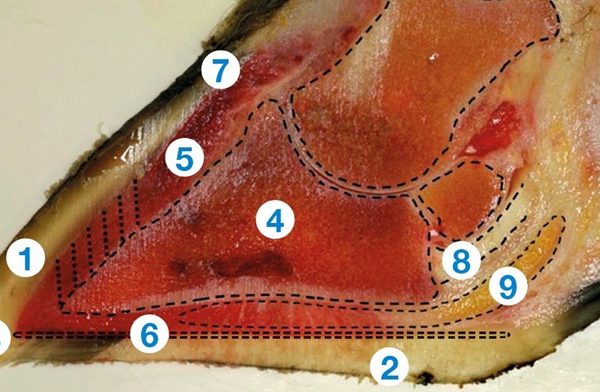Foot Trimming
Effective Foot Trimming
The recent Sustainable Agriculture Capital Grant Scheme (SACGS) included an option for specialist foot trimming crushes and foot trimming add-ons to crushes. So, with a fair amount of foot trimming equipment potentially landing on farms in the next couple of months, it is a good time to look at effective foot trimming, which requires a good understanding of foot anatomy.
Source: AHDB

- Wall horn – the main weight bearing part of the hoof. It is the strongest horn and grows at a rate of 0.4 to 0.5cm per month.
- Sole horn - around 1 to1.5cm thick. Sole horn will absorb moisture and the higher the moisture content in the sole horn, the faster it wears. Formalin and copper sulphate can draw moisture out of the sole horn. A dry environment for the hoof may achieve the same effect.
- White line – where the sole horn joins to the wall horn (an area of weakness).
- Pedal bone – the main bone in the hoof.
- Laminar corium – tissue protecting the pedal bone within the hoof capsule.
- Sole corium – where new sole horn is produced. Damage here can result in sole ulcers.
- Coronary band – found along the hairline at the top of the hoof wall. This is where new horn grows down from. It can take a year to reach the end of the toe and takes five months to heal.
- Flexor tendon – injury or infection can lead to misalignment, or “corkscrew claw”.
- Digital cushion – a protective fat pad that supports the pedal bone by absorbing force applied to the foot. It works like an insole in a shoe. Cows that have lost weight and are in poor body condition will have a thinner digital cushion. This can cause discomfort and, in severe cases, can cause damage to the pedal bone. The regrowth of a damaged pedal bone can be excessive, leading to permanent “spurs” jutting out of the bone that will cause permanent discomfort.
When to trim
Regular mobility scoring is essential for early detection of lameness and should be carried out on a monthly basis. It is important not wait to treat a lame cow and record cases. This makes it easier to identify cows for follow up checks.
Routine trimming should be carried out around drying off (ideally not the day of drying off due to potential mastitis risk). Heifers should also be checked for overgrown claws 6 to 8 weeks prior to calving. This means all stock will calve with feet in good condition.
In grazing herds, cows should be checked 4 to 8 weeks before turnout. This will allow for regrowth of horn and modelling of the interdigital space to reduce the risk of stones getting trapped between the claws.
Foot trimming basics
Whilst it is possible to learn the principles by reading, there is no substitute for learning the practical skills with a qualified claw trimming instructor. Small differences in trimming method can have a major impact on claw health and so formal training on best practice is recommended and probably highly cost-effective.
The aim of most foot trimming methods is to make the claws the correct length and the sole of the inner and outer claw level. This will correct imbalances in weight bearing between the claws.
If a lesion is found, all loose horn surrounding it should be removed while taking care not to damage the corium. This will avoid the regrowth being “underrun”. The pressure on the affected claw can be reduced by using a wooden or plastic block on the healthy claw. Many professional foot trimmers used a blow torch or heat gun to remove all moisture from the claw and block. This gives the adhesive the best chance to stick properly.
Bandages should only be used to keep treatment pastes in place. It is important that they are not put on too tightly as this will reduce blood flow to the corium and delay healing. Remove bandages after a few days to avoid infection from dirt or moisture that they may attract. The treated claw will heal more quickly if air can get in and dirt can get out.
Grinders are very effective at removing horn very quickly. They can also cause a great deal of damage when used incorrectly. If inexperienced, it is best to use a less aggressive disc to reduce risk of damage. If using a grinder, it is very important that the cow’s foot is secured properly and cannot move.
Knives should be kept sharp and should be used to remove a small amount of horn at a time. A blunt knife requires more force to remove horn which can lead to reduced accuracy.
If unsure of how to properly treat lameness in a cow, it is best to consult a qualified foot trimmer or your vet.
Sign up to the FAS newsletter
Receive updates on news, events and publications from Scotland’s Farm Advisory Service
